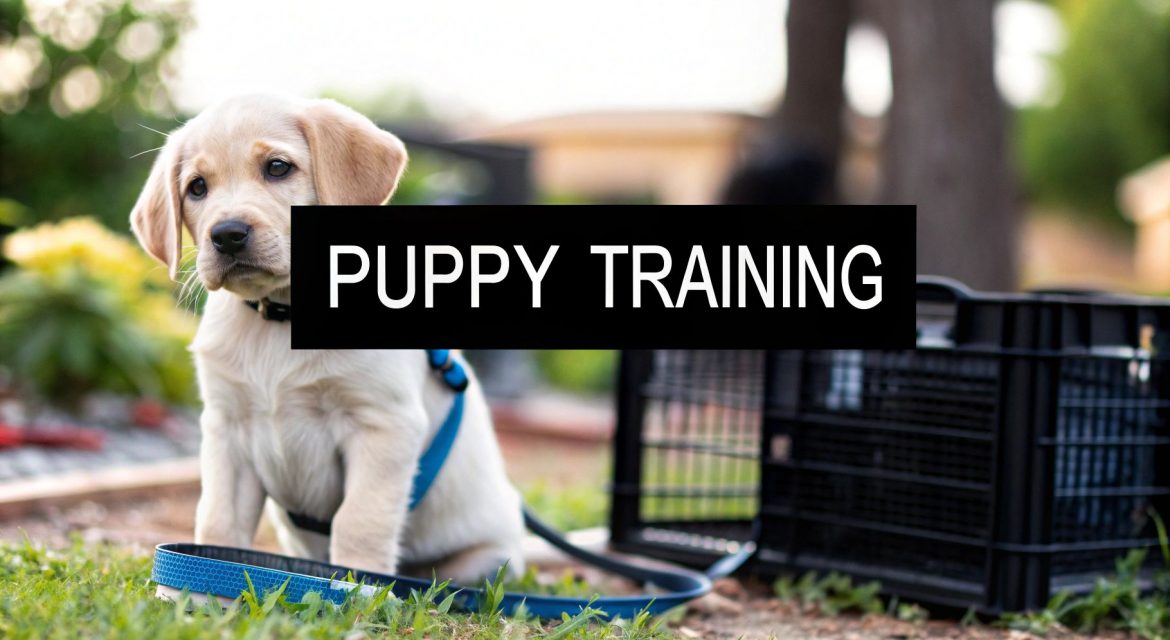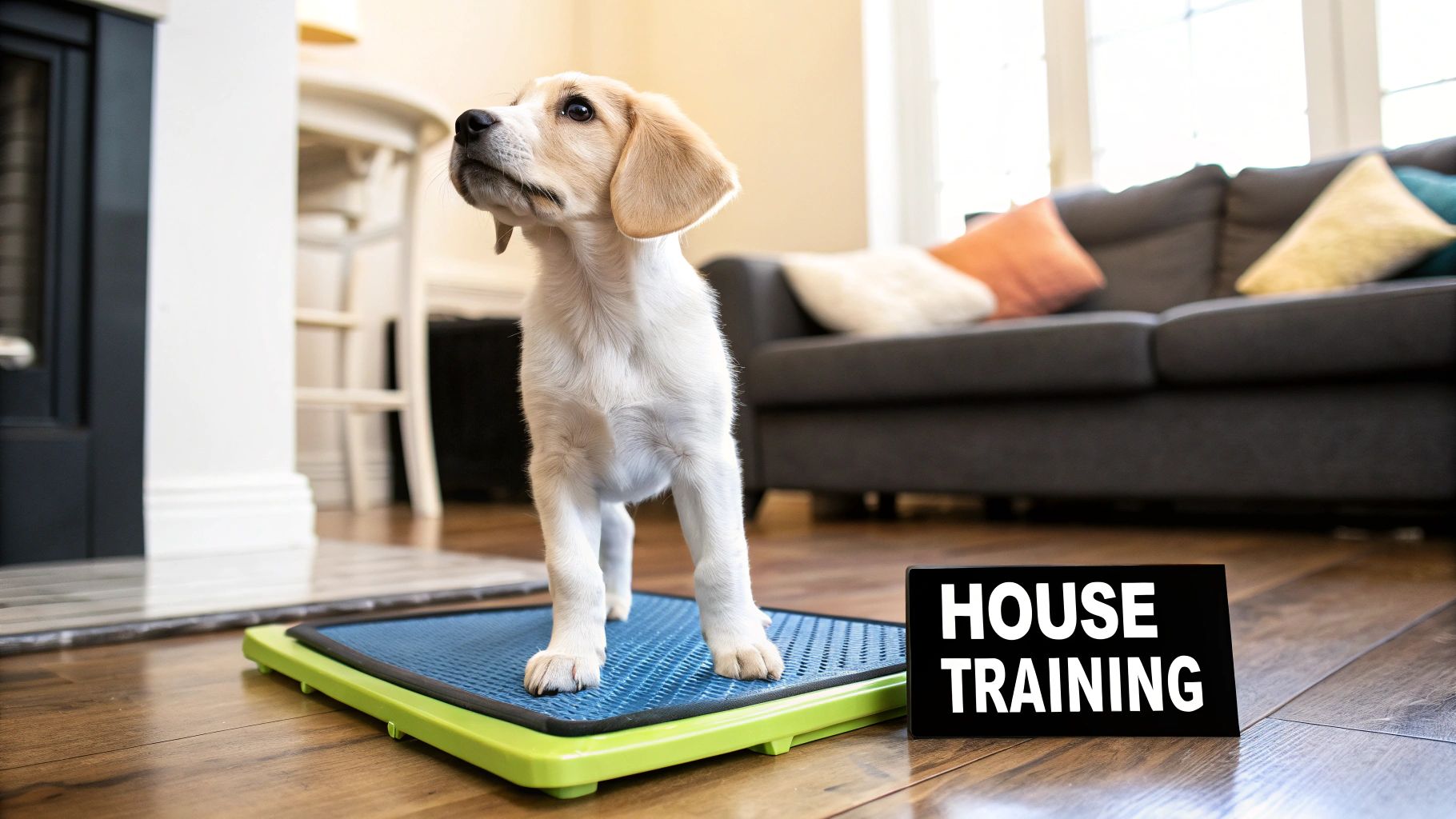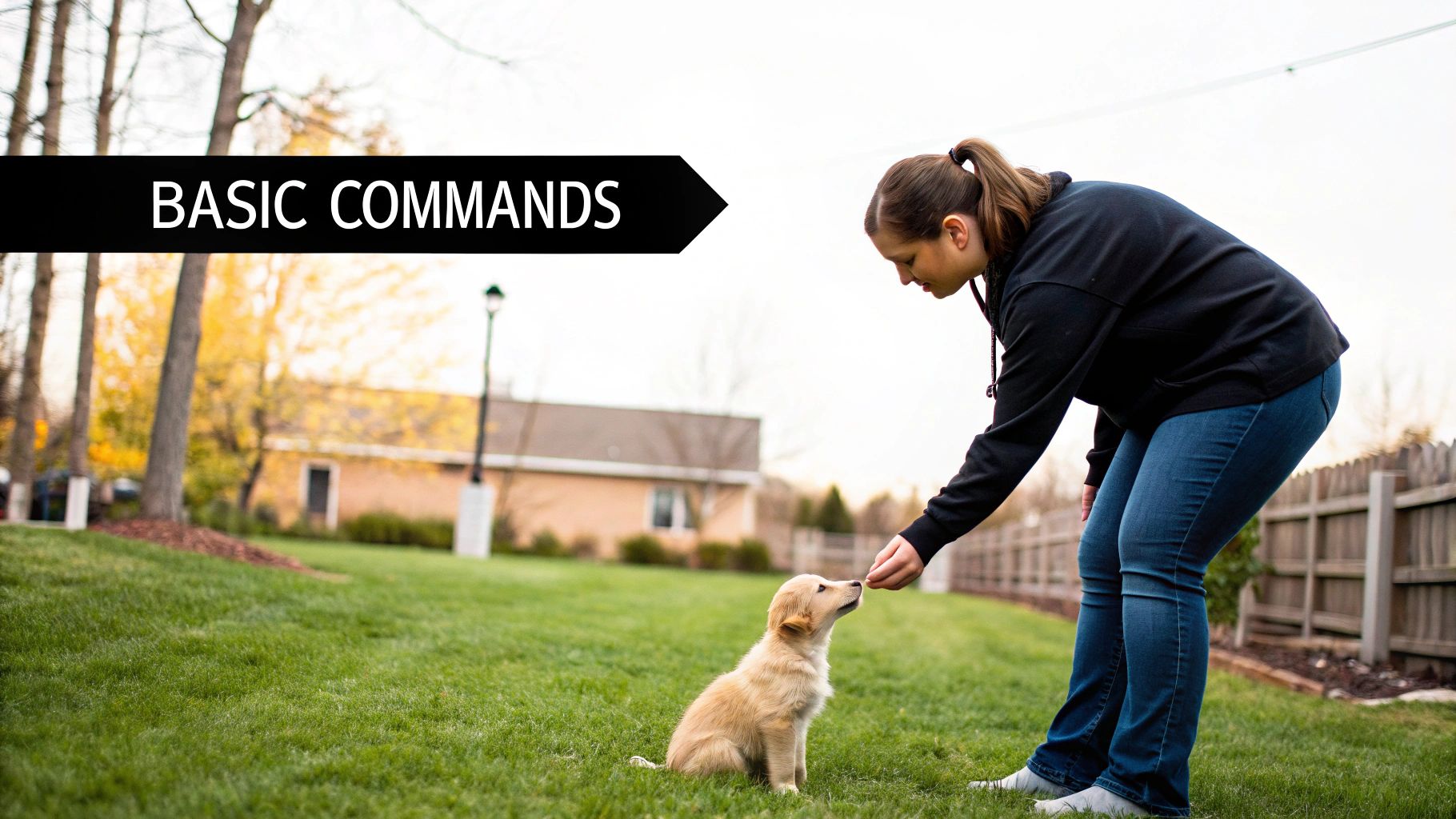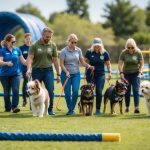So, you’re wondering how to train a puppy? After years of working with them, we can tell you the simplest answer is this: a blend of consistency, patience, and positive reinforcement. This isn't just about teaching commands; it's about us building a common language and a deep bond of trust with your new best friend, right from the very start.
Starting Your Puppy Training Journey
Bringing a new puppy home is one of life’s most joyful moments. But that initial buzz is often followed by a wave of questions and, let's be honest, a touch of overwhelm. If that sounds familiar, please know you are absolutely not alone. We've all been there, standing in a puddle, wondering if we're getting any of it right.
Think of this guide as a supportive friend who's been through it all before. We’re here to walk you through this incredible adventure, covering everything from prepping your home and mastering those first commands to navigating potty training mishaps and making sure your little one grows into a happy, confident dog.
Why Early Training Matters So Much
The moment your puppy sets a paw over the threshold, their education begins. They are constantly learning from you, whether you’re actively training or just making a cup of tea. This is precisely why starting a gentle, positive routine from day one is so crucial.
The goal isn’t immediate perfection. It’s about establishing clear, kind communication and showing your puppy that learning with you is a fun and rewarding game. Every small success builds a foundation of trust that will last a lifetime.
You're not just teaching "Sit" or "Stay"; you're teaching them how to live happily and safely in our human world. This early effort is your best bet for preventing common behavioural issues down the line, making life more enjoyable for both of you.
You Are Part of a Growing Community
It might feel like a very personal challenge, but you're joining a massive community of dog lovers. You are far from the only one figuring out how to train a puppy right now. In the UK, dog ownership has skyrocketed, with over 13.5 million dogs now sharing our homes.
In fact, a recent surge saw more than 3 million households welcome a new dog, many of them puppies in desperate need of guidance. This has really shone a light on how vital early training is, with experts recommending it begins as early as 8 weeks old to make the most of their key socialisation period. Feel free to explore more UK dog ownership statistics to see just how big our community is.
By embracing this journey, you’re giving your puppy the best possible start. Together, we’ll turn those moments of doubt into moments of pure pride, one paw-sitive step at a time.
Preparing Your Home for a New Puppy
The real work of training a puppy starts long before they set a paw inside your home. Setting up a safe, welcoming space isn't just about picking out a cute bed; it's about creating a foundation for a smooth transition for both of you. Getting this right from day one can save you a world of chaos in those first few weeks.
Think about it from their point of view: they're leaving their mum, their siblings, and everything familiar. A bit of thoughtful prep goes a massive way in helping them feel secure and start to understand the rules of their new world.
Creating a Safe Den
One of the best tools you'll ever have is a crate. It’s not a cage. Think of it as your puppy’s own personal den—a safe, secure spot where they can retreat and relax. This taps into their natural denning instinct, which is a huge advantage for house training and preventing separation anxiety down the line.
When you're picking a crate, it needs to be big enough for your puppy to stand up, turn around, and lie down, but not so big they can set up a toilet at one end and a bedroom at the other. For a proper deep dive into getting this right, our guide on how to crate train a puppy is an absolute game-changer.
Remember: The crate must always be a happy place. Never, ever use it for punishment. Tossing a high-value treat inside or feeding meals in there helps build a brilliant, positive connection.
Puppy-proofing is your next big job. Seriously, get down on your hands and knees and see the world from their level. What looks tempting? Electrical cords are a huge danger, so tuck them away or use covers. Make sure low cupboards are secured, especially those with cleaning chemicals, and move any houseplants that could be toxic.
Gathering Your Essential Gear
It’s tempting to go wild in the pet shop, but you only need a few key items to get started. Focus on gear that will actually support your training efforts.
Here’s a practical list to get you on your way:
- A Comfortable Harness and Lead: A well-fitted harness is much better than a collar for walks, as it avoids putting pressure on a puppy's delicate neck.
- High-Value Training Treats: These need to be small, soft, and way more exciting than their normal food. Think tiny bits of cooked chicken, cheese, or specific training treats they can swallow in a second.
- Appropriate Chew Toys: Puppies explore everything with their mouths. A good variety of safe chew toys, like rubber Kongs or durable teething rings, will be a lifesaver for your furniture.
- Enzymatic Cleaner: Accidents are a given. An enzymatic cleaner is non-negotiable because it breaks down the proteins in urine, completely getting rid of the smell so your pup isn't drawn back to the same spot.
Establishing a Routine from Day One
Dogs, especially puppies, thrive on predictability. A consistent daily routine helps them feel secure and learn the house rules incredibly quickly. This doesn't mean you need a military-style schedule, but a general rhythm makes all the difference.
From their very first day, try to set a pattern for key activities. This means consistent times for meals, frequent potty breaks, and scheduled slots for both playtime and quiet naps. For example, a good rule of thumb is to take your puppy out immediately after they wake up, right after they eat, and after a good play session.
By doing this, you're not just managing their day; you're proactively teaching them what to expect. This simple structure is a cornerstone of puppy training, reducing their anxiety and helping them settle into their new home with confidence.
House Training Your Puppy
Right, let's talk about the big one: house training. If you're feeling a bit overwhelmed by the thought of puddles and poop, take a deep breath. You are in very, very good company. This is often the biggest hurdle for new puppy owners, but we promise you, with a solid plan and a healthy dose of patience, we can get this sorted together.
The secret isn't about avoiding accidents completely—that's a tall order for any puppy. It's about setting your little one up for success so that doing their business outside becomes second nature. We're going for positive reinforcement and understanding, not telling them off. Think of this as your first big communication test; getting it right builds a massive amount of trust.
Building a Reliable Potty Schedule
Puppies, especially the really young ones, have tiny bladders and almost zero control. A good rule of thumb is that a puppy can hold it for about one hour for every month of their age, plus one. So, a two-month-old pup might manage up to three hours at a push, but honestly, it’s best not to test that limit.
Your best bet is a proactive, predictable schedule. This means lots of supervised trips outside to their designated toilet spot. The most crucial times are:
- Immediately after waking up: First thing in the morning and after every single nap, no exceptions.
- Shortly after eating or drinking: A full tummy often puts pressure on everything else.
- Following a play session: All that excitement can make them forget they need to go until it's an emergency.
- Before bedtime: One last chance for an empty tank before settling down for the night.
When you take them out, keep it business-like. Use a specific phrase like "go potty" or "be quick" in a calm, encouraging tone. The second they finish, pile on the praise and give them a really tasty treat. This positive reinforcement is what clicks in their brain: "Aha! I did the right thing in the right place!"
Learning to Read Your Puppy's Signals
Every puppy has their own little "I need to go" dance. Learning to spot these tells is a complete game-changer because it means you can get ahead of accidents before they even happen. You'll quickly become an expert in their body language.
Keep an eye out for these common signs:
- Intense sniffing: Suddenly becoming fascinated with the floor.
- Circling: Pacing around in a tight little circle is a classic.
- Whining or restlessness: A sudden switch from calm to agitated.
- Heading for the door: They might go and sit or scratch at the door they use to go outside.
The moment you see any of these behaviours, don't hesitate. Calmly scoop them up or lead them straight outside to their spot. It hammers home that connection between the urge to go and the correct place to do it.
The Role of Crate Training in Potty Success
As we touched on earlier, a crate is one of the most powerful tools you have for house training. It works by tapping into a dog's natural instinct to keep their den clean. Most puppies will instinctively do everything they can to avoid soiling the area where they sleep.
This visual shows a puppy resting comfortably in their crate, a key component of effective house training.
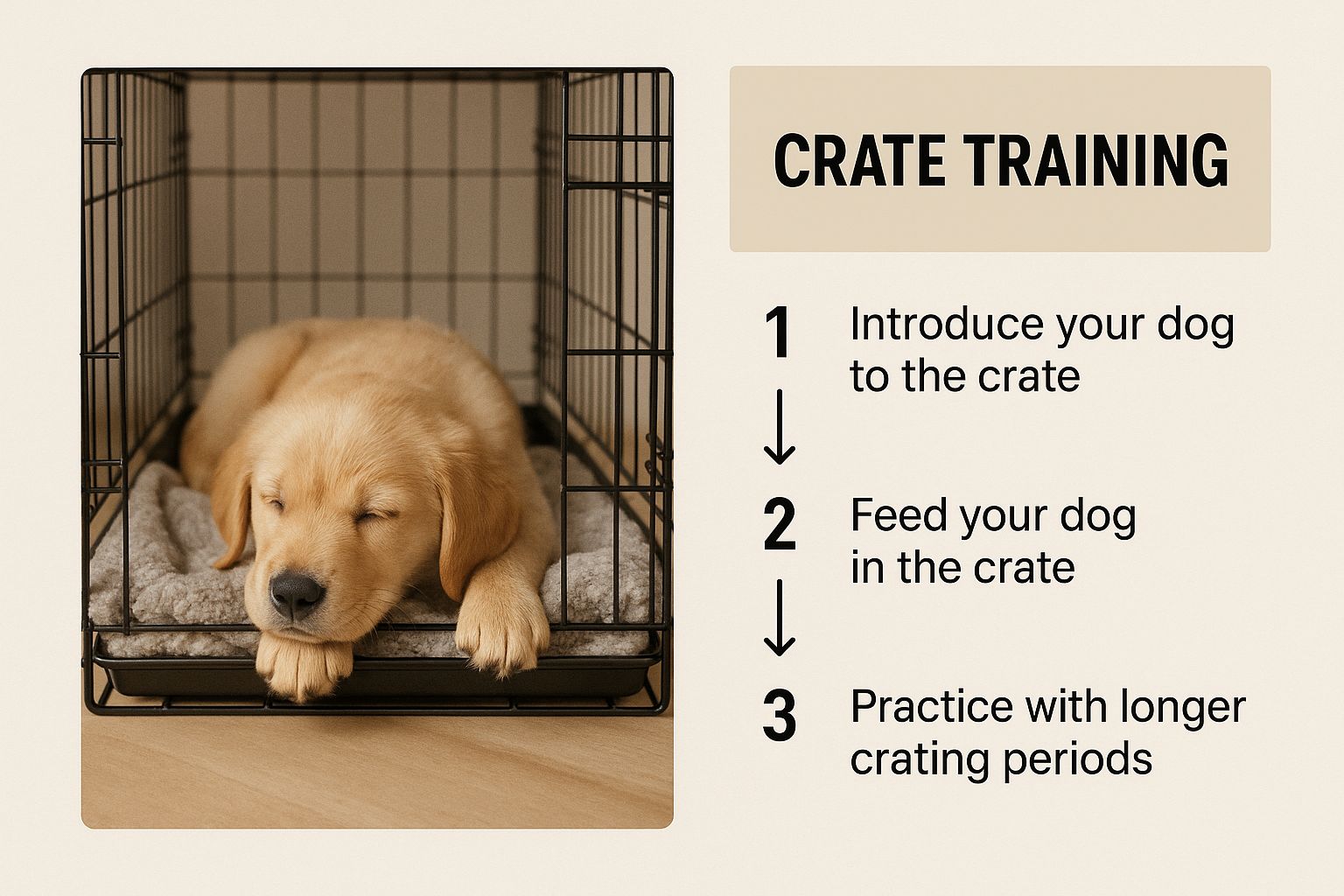
By making the crate a safe, cosy haven, it becomes your best friend for preventing accidents when you can't have eyes on your puppy 24/7.
When used properly, the crate helps you manage your puppy’s freedom and predict when they need a potty break. For example, you know that after a nap in their crate, a trip outside is almost guaranteed to be needed immediately. It's not a jail, but a brilliant management tool that supports your training schedule and gives you both peace of mind.
To give you a better idea, here is a sample schedule you can adapt.
Sample Puppy Potty Break Schedule
Use this as a starting point. Your puppy's individual needs may vary, so observe them closely.
| Puppy's Age | Maximum Time Between Breaks | Key Focus |
|---|---|---|
| 8-10 weeks | 1 hour | Establishing a strong routine; frequent trips are key. |
| 10-12 weeks | 2 hours | Learning to read signals; rewarding success heavily. |
| 3-6 months | 3-4 hours | Gaining control; phasing out overnight breaks. |
| 6+ months | 6-8 hours | Solidifying habits; maintaining a consistent schedule. |
Remember, this is just a guide. A tiny breed will have a smaller bladder than a large breed of the same age. Always err on the side of more breaks, not fewer.
Handling Accidents with Grace
Accidents will happen. It's a non-negotiable part of puppyhood. How you react in that moment is what truly matters. The absolute worst thing you can do is scold or punish your puppy. This only teaches them that you're scary and unpredictable, which can lead to them hiding from you to do their business—making house training ten times harder.
Your mantra should be: Clean, ignore, and move on. There is no value in punishing a puppy for an accident. Your energy is far better spent on preventing the next one.
When an accident occurs, you need to clean it up properly with an enzymatic cleaner. Your standard household sprays won't do the job. An enzymatic cleaner uses biology to break down the urine proteins, completely removing the scent that would otherwise act like a magnet, drawing your puppy back to the same spot.
For those of us in flats or with shared gardens, it's also about being a good neighbour. Always have your poo bags at the ready and be diligent about cleaning up immediately. If you're using puppy pads as a temporary measure, place them right by the door to start building the association with going outside. The ultimate goal is always to phase them out as your puppy gains more bladder control and fully grasps the "outside is for potty" rule. It’s a process, but your consistency will absolutely pay off.
Teaching Basic Puppy Commands
Right, so your puppy's settling in. Now for the really fun part: teaching them the ropes. This isn't about turning your pup into a four-legged robot. It's about building a shared language so you can navigate life together safely and have a lot more fun along the way. This is where your bond truly begins to take shape.
The secret? Keep it fun. Seriously. A puppy's attention span is fleeting, so short, upbeat training sessions are your best friend. A few minutes here and there throughout the day will achieve far more than a single, long-winded training marathon that leaves you both drained. Your goal is to make learning with you the best game they’ve ever played.
The Magic of Positive Reinforcement
Everything from here on out is built on positive reinforcement. It’s a simple, kind, and incredibly effective method. All it means is that you reward the behaviour you want to see, which makes your puppy far more likely to do it again. A reward can be a delicious treat, their favourite squeaky toy, or just a burst of enthusiastic praise.
You'll often start by using a tasty, high-value treat as a lure. Think of it as a little magnet you use to guide your puppy into the right position. The moment they do what you're hoping for, you give them the treat and a clear verbal cue. It’s a brilliant way for them to connect the dots between an action and a word.
The goal is to show your puppy what you want them to do, rather than correcting them for what you don't. This approach builds confidence and trust, making your puppy an enthusiastic and willing partner in their own training.
How to Teach Sit
"Sit" is the classic first command for a reason. It’s a fantastic building block for teaching calmness and focus. You'll find yourself using it all the time—like asking for a quick sit before clipping on their lead to stop that frantic, jumpy excitement.
- Grab a tasty treat and hold it near your puppy’s nose.
- Slowly lift the treat up and back, moving it over their head. As their nose follows the treat upwards, their bottom will naturally lower into a sit.
- The very second their bum hits the floor, say "Sit!" in a cheerful, clear voice and give them the treat along with plenty of praise.
Resist the urge to push their bum down; let them work out the movement for themselves. After a few repetitions, you'll find they start offering a sit as soon as they see you reach for the treat jar!
Mastering Come When Called
A reliable "Come" (or recall) is arguably the most important, life-saving command you will ever teach your puppy. The aim is to make running back to you the absolute best thing they could possibly do at any given moment.
Start this game in a quiet room with zero distractions.
- Ask a friend or family member to gently hold your puppy while you walk a few feet away with a super exciting toy or some delicious-smelling treats.
- Call your puppy’s name followed by "Come!" in your happiest, most excited voice.
- As your partner lets them go, crouch down with your arms open wide. When they reach you, shower them with a "jackpot" of treats and a ridiculous amount of fuss.
A word of warning: never, ever punish your puppy for coming back, no matter how long it took them. You need them to associate returning to you with wonderful, positive things, always. As they get the hang of it, you can gradually increase the distance and start practising in slightly more distracting places, like a secure garden.
Teaching a Calm Down
The "Down" command is a game-changer for teaching your pup to settle. It's perfect for when you have visitors over, or you're trying to enjoy a quiet pint at a dog-friendly pub. It’s a much more relaxed, settled position than a sit.
You can easily teach this from a sit.
- With your puppy sitting, hold a treat near their nose.
- Lower your hand straight down between their front paws. Their nose will follow the treat, and they should naturally lie down to get it.
- As soon as their elbows touch the ground, say "Down" and give them the reward.
Don't worry if they pop straight back up again at first. That's totally normal! The key is to reward that initial movement. Over time, you can gradually increase how long they stay in the "Down" position. For more in-depth guidance on various techniques, check out our extensive resources on dog training.
The Lifesaving Leave It Command
Think of "Leave It" as your emergency brake. This command teaches your puppy to ignore a dropped item—whether that's a rogue piece of chocolate in the kitchen or something unspeakable they've found on a walk.
Start with two different kinds of treats: something a bit boring (like their regular kibble) and something irresistible (like small pieces of chicken).
- Close your fist around the boring kibble and let your puppy have a good sniff and lick. The instant they pull their head away, even for a split second, say "Yes!" and give them the high-value chicken from your other hand.
- Repeat this until they automatically back away from your closed fist when you present it.
- Once they're doing that reliably, you can add the verbal cue "Leave It" just before you present your fist.
- The final step is to practise with a treat on the floor, first covered by your hand, and eventually, uncovered.
This one takes real time and consistency, but its value for keeping your puppy safe is immeasurable. A growing trend in the UK shows that owners are increasingly seeking expert help for this kind of crucial training. In fact, 41% of Gen Z pet owners now invest in professional pet training, valuing structured guidance over going it alone. This cultural shift highlights just how important getting these foundational skills right has become for a new generation of dog lovers. You can discover more insights into UK pet training service trends and see how the community is evolving. Your commitment to training puts you right at the forefront of this positive movement.
Socialising Your Puppy for a Confident Future
Socialisation is, without a doubt, one of the most incredible and lasting gifts you can give your puppy. It's so much more than just letting them meet other dogs; it's about gently and positively introducing them to the huge variety of sights, sounds, smells, and textures our human world has to offer. When you get this right, you're helping them grow into a confident, resilient adult who can take life in their stride.
Think of it this way: you're not just trying to teach them that the world is safe. You're showing them that you are their safe harbour, the one they can always trust when something new or a bit strange comes along. This process builds an incredible depth to your bond.
The Critical Socialisation Window
There's a magical, but brief, period in your puppy's life, roughly between 3 and 16 weeks of age, known as the critical socialisation window. During this time, their brains are like little sponges, soaking up information about what is safe and normal.
Positive experiences during this phase have a lifelong impact, shaping a dog who is curious and friendly rather than fearful. On the flip side, a lack of exposure can lead to anxiety and fear-based behaviours later on. The clock really is ticking from the moment you bring them home, which is why it’s so important to have a plan.
Your primary job during this time is to be your puppy's trusted guide. The goal is to create positive associations with as many different things as possible, ensuring every new encounter is a happy and reassuring one.
It can feel like a lot of pressure, we know. But try to think of it as a fun checklist of adventures for you and your new best friend to share. We are not aiming for overwhelming, high-intensity exposure. Gentle, controlled, and positive introductions are the name of the game.
Building a World of Positive Experiences
So, what should you actually be introducing your puppy to? The short answer is… almost everything! We want them to experience a wide range of everyday things so they learn not to be frightened by them.
Your goal is to manage these introductions so your puppy feels secure, not overwhelmed. For instance, instead of taking them to a loud, crowded market straight away, start by sitting on a park bench far away from the action. Let them watch from the safety of your lap while you give them tasty treats.
Here’s a practical checklist to get you started:
- Different Surfaces: Let them walk on grass, pavement, carpet, and wooden floors. Maybe even get them to step on a wobbly cushion to build their physical confidence.
- Household Noises: The rumble of the washing machine, the roar of the vacuum cleaner (from a safe distance at first!), the television, and the doorbell. Pair these sounds with high-value treats to make them no big deal.
- People: Introduce them to all sorts of people—men with beards, people wearing hats or glasses, children (always supervised!), and people in wheelchairs or using walking sticks.
- Outdoor Sights and Sounds: The sight and sound of buses, cars, and bicycles going past. Start far away and gradually get closer over several sessions.
Remember, every puppy is an individual. Watch their body language like a hawk. If they seem scared, you’ve probably moved too fast. Simply increase the distance and give them more time and reassurance. For a more detailed plan, you can learn more about how to socialise a puppy in our dedicated guide.
The Value of Puppy Training Classes
While socialising your puppy to the world is vital, interacting with their own kind is just as important. This is where a good puppy training class becomes an invaluable part of your journey. They are so much more than just a place to learn "Sit".
Reputable puppy classes in the UK provide a controlled, safe environment where your pup can interact with other vaccinated puppies of a similar age. This is a cornerstone of responsible dog ownership.
Under the watchful eye of a qualified trainer, your puppy will learn appropriate play etiquette, how to read other dogs' signals, and how to interact politely. These early lessons are brilliant for preventing problems like fear-based reactivity or bullying behaviour at the dog park later on. It's a fantastic, structured way to tick off a huge part of their socialisation education while getting expert guidance for yourself.
Troubleshooting Common Puppy Problems
Right, let's tackle some of those classic puppy predicaments. No matter how much you prepare, there will be moments that test your patience and have you questioning everything. It's totally normal. These little hiccups are just part of the journey, not a sign that you're failing.
Honestly, every new puppy owner goes through it. With a bit of understanding and the right game plan, we can handle these tricky spots with confidence. Think of it as another way we can build that amazing bond together.
How Can I Stop My Puppy From Biting and Nipping?
First things first: take a deep breath. A nippy puppy is a normal puppy. This isn't aggression—it’s how they explored the world with their littermates. Now, it's your job to teach them about bite inhibition, which is a compassionate way of saying "how to be gentle with your mouth."
The moment you feel those sharp little teeth on your skin, even if it's gentle, let out a high-pitched "Ouch!" or "Yip!" Immediately pull your hand away and stop all interaction. This sharp, sudden sound is exactly what another puppy would do to say, "Hey, that was too rough!" It’s a language they already understand.
The real secret is to show them what they can chew on, not just what they can't. After you've said "Ouch!" and had a brief pause, offer them a proper chew toy. This redirects them and teaches a simple, golden rule: toys are for chewing, people are not.
Everyone in your house must be on the same page with this. Consistency is everything. Whatever you do, please avoid physical corrections like holding their mouth shut. This usually just creates fear and can actually make the nipping worse.
What Should I Do If My Puppy Cries All Night in Their Crate?
Oh, those heartbreaking midnight whimpers. We’ve all been there, lying awake and feeling awful. But with a little empathy and patience, we can help your pup see their crate as a cosy, safe den, not a punishment.
Start by making the crate the best place on earth. Feed them their meals in there. Give them amazing, high-value toys they only get when they're inside. For the first few nights, it's a game-changer to have the crate right next to your bed. Your presence, your scent, and the sound of your breathing are incredibly reassuring. They know they haven't been left alone.
If the crying starts, run through this quick mental checklist:
- Do they need the toilet? Calmly take them outside on a lead for a very boring toilet break. No fun, no games, no exciting chat.
- Is it just for attention? Once you're sure their needs are met, it’s straight back into the crate. A warm hot water bottle wrapped in a blanket can work wonders to mimic the warmth of their mum and littermates.
It's tough, we know, but try to resist letting them out just because they are crying. Sticking with it teaches them that whining doesn't open the crate door, but sleeping quietly does.
When Is the Right Time to Join Puppy Classes in the UK?
Getting your pup into a good class is one of the best things you can do for their future confidence. In the UK, you'll want to sign up as soon as your vet gives the all-clear after their second set of vaccinations. This is usually around 10-12 weeks of age.
This timing is absolutely critical because it lands right in the middle of their key socialisation window, which starts to close around 16 weeks. A well-managed puppy class provides a safe, controlled space for them to meet other pups and people.
Any reputable UK class, like those approved by The Kennel Club, will insist on seeing proof of vaccination. This ensures every puppy there is protected, so you can focus on the fun of watching your little one learn and grow.
At My Life My Dog, we believe that every owner has the power to build an incredible bond with their dog. Our platform is filled with expert guides and supportive advice to help you through every stage of your journey together. Discover more resources and become part of our community at https://mylifemydog.com.


